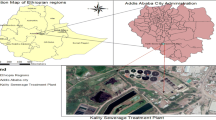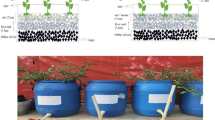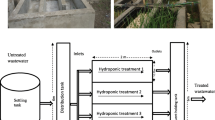Abstract
Brewery industries generate large amounts of wastewater rich in organic matter originating from the brewing process, and they are among the major polluting industries. This study aimed to assess the phytoremediation of brewery wastewater using horizontal subsurface flow constructed wetlands (HSFCWs) vegetated with Typha latifolia and Pennisetum purpureum for organics removal and plant growth analysis. Six parallel pilot-scale HSFCWs were constructed and operated to assess potential of treating wastewater sourced from St. George brewery factory located in Addis Ababa, Ethiopia. Three units were planted with T. latifolia and the other three with P. purpureum with one control without plants for each species. Primarily settled wastewater was fed evenly to them by gravity. Wastewater quality, plant growth analysis and system efficiency were observed during the experiment following standard methods. Both plants grew and established well, however, T. latifolia had more biomass and vigorous growth and showed good phytoremedial capacity to remove organic pollutants. Average removal efficiencies for BOD5 and COD were significant (p < 0.05), up to 87% (inlet BOD5 of 748–1642 mg l−1) and up to 81% (inlet COD of 835–2602 mg l−1) and T. latifolia slightly outperformed P. purpureum. Estimated biomass of significant (p < 0.05) value (0.61–0.86 kg DW m−2) was produced. HSFCWs are green and environmentally sustainable technology that offers promising alternative wastewater treatment method in developing countries of tropical climate due to its low-tech nature. Integrating treatment and biomass production needs further improvement.





Similar content being viewed by others
References
United Nations Environment Program (UNEP) (2008) Africa Review Report on Sustainable Consumption and Production. UNEP, Addis Ababa
Joshua OO, Kehinde AI (2014) Life cycle assessment and management of water use in selected breweries in Nigeria. Civil Eng Archit 2(5):191–200. https://doi.org/10.13189/cea.2014.020501
Nebyou S (2011) Technical efficiency analysis of the Ethiopian brewery industry. Dissertation, Addis Ababa University
Olajire AA (2012) The brewing industry and environmental challenges. J Clean Prod. https://doi.org/10.1016/j.jclepro.2012.03.003
Fillaudeau L, Blanpain-Avet P, Daufin G (2006) Water, wastewater and waste management in brewing industries. J Clean Prod 14(5):463–471
Hultberg M, Bodin H (2017) Fungi-based treatment of brewery wastewater-biomass production and nutrient reduction. Appl Microbiol Biot 101(11):4791–4798
Simate GS (2015) The treatment of brewery wastewater for reuse by integration of and coagulation/flocculation sedimentation with carbon nanotubes ‘sandwiched’ in a granular filter bed. J Ind Eng Chem 21:1277–1285
Ojoawo SO, Udayakumar G, Naik P (2015) Phytoremediation of phosphorus and nitrogen with Canna x generalis reeds in domestic wastewater through NMAMIT constructed wetland. Aquat Procedia 4:349–356
Dipu S et al (2010) Phytoremediation of dairy effluent by constructed wetland technology using wetland macrophytes. Glob J Environ Res 4(2):90–100
Mwangi SW et al (2014) The efficacy of a tropical constructed wetland for treating wastewater during the wet season: the Kenyan experience. J Environ Earth Sci 4(15):66–73
Hadad H, Maine M, Bonetto C (2006) Macrophyte growth in a pilot-scale constructed wetland for industrial wastewater treatment. Chemosphere 63(10):1744–1753
Kantawanichkul S, Kladprasert S, Brix H (2009) Treatment of high-strength wastewater in tropical vertical flow constructed wetlands planted with Typha angustifolia and Cyperus involucratus. Ecol Eng 35(2):38–247
Brix H (1994) Functions of macrophytes in constructed wetlands. Water Sci Technol 29(4):71–78
Stottmeister U, Wießner A, Kuschk P, Kappelmeyer U, Kästner M, Bederski O, Müller R, Moormann H (2003) Effects of plants and microorganisms in constructed wetlands for wastewater treatment. Biotechnol Adv 22(1):93–117
Vymazal J (2005) Horizontal sub-surface flow and hybrid constructed wetlands systems for wastewater treatment. Ecol Eng 25(5):478–490
Saeed T, Sun G (2012) A review on nitrogen and organics removal mechanisms in subsurface flow constructed wetlands: dependency on environmental parameters, operating conditions and supporting media. J Environ Manag 112:429–448
Calheiros CS, Rangel AO, Castro PM (2009) Treatment of industrial wastewater with two-stage constructed wetlands planted with Typha latifolia and Phragmites australis. Bioresour Technol 100(13):3205–3213
Alemu T, Lemma E, Mekonnen A, Leta S (2016) Performance of pilot scale anaerobic-SBR system integrated with constructed wetlands for the treatment of tannery wastewater. Environ Process 3(4):815–827
Calheiros CS, Rangel AO, Castro PM (2007) Constructed wetland systems vegetated with different plants applied to the treatment of tannery wastewater. Water Res 41(8):1790–1798
Vipat V, Singh U, Billore S (2008) Efficacy of rootzone technology for treatment of domestic wastewater: field scale study of a pilot project in Bhopal.(MP), India. In: The 12th world lake conference
Pavlineri N, Skoulikidis NT, Tsihrintzis VA (2017) Constructed floating wetlands: a review of research, design, operation and management aspects, and data meta-analysis. J Chem Eng 308:1120–1132
Leta S et al (2004) Biological nitrogen and organic matter removal from tannery wastewater in pilot plant operations in Ethiopia. Appl Microbiol Biotechnol 66(3):333–339
Vymazal J, Kröpfelová L (2008) Wastewater treatment in constructed wetlands with horizontal subsurface flow. Czech Republic, Kamýcká
Kaseva M (2004) Performance of a sub-surface flow constructed wetland in polishing pre-treated wastewater—a tropical case study. Water Res 38(3):681–687
Kelvin K, Tole M (2011) The efficacy of a tropical constructed wetland for treating wastewater during the dry season: the Kenyan experience. Water Air Soil Poll 215(1–4):137–143
Zhang DQ et al (2014) Application of constructed wetlands for wastewater treatment in developing countries—a review of recent developments (2000–2013). J Environ Manag 141:116–131
Wu S, Wallace S, Brix H, Kuschk P, Kirui WK, Masi F, Dong R (2015) Treatment of industrial effluents in constructed wetlands: challenges, operational strategies and overall performance. Environ Pollut 201:107–120
Aslam MM, Sarfraz H, Baig M (2010) Removal of metals from the refinery wastewater through vertical flow constructed wetlands. Int J Agric Biol 12(5):796–798
Tanner CC (1996) Plants for constructed wetland treatment systems—a comparison of the growth and nutrient uptake of eight emergent species. Ecol Eng 7(1):59–83
Pastor R, Benqlilou C, Paz D, Cardenas G, Espuña A, Puigjaner L (2003) Design optimisation of constructed wetlands for wastewater treatment. Resour Conserv Recycl 37(3):193–204
Valipour A, Raman VK, Ahn YH (2015) Effectiveness of domestic wastewater treatment using a bio-hedge water hyacinth wetland system. Water 7(1):329–347
Jamshidi S, Akbarzadeh A, Woo KS, Valipour A (2014) Wastewater treatment using integrated anaerobic baffled reactor and Bio-rack wetland planted with Phragmites sp. and Typha sp. J Environ Health Sci Eng 12(1):1–12
Wu H, Zhang J, Ngo HH, Guo W, Hu Z, Liang S, Fan J, Liu H (2015) A review on the sustainability of constructed wetlands for wastewater treatment: design and operation. Bioresour Technol 175:594–601
American Public Health Association (APHA) (1999) Standard methods for the examination of water and wastewater, 20th edn. American Public Health Association, Washington
Kouki S et al (2009) Performances of a constructed wetland treating domestic wastewaters during a macrophytes life cycle. Desalination 246:452–467
Sudarjanto G, Sharma KR, Gutierrez O, Yuan Z (2011) A laboratory assessment of the impact of brewery wastewater discharge on sulfide and methane production in a sewer. Water Sci Technol 64(8):1614–1619
Simate GS, Cluett J, Iyuke SE, Musapatika ET, Ndlovu S, Walubita LF, Alvarez AE (2011) The treatment of brewery wastewater for reuse: state Art. Desalination 273(2):235–247
Driessen W, Vereijken T (2003) Recent developments in biological treatment of brewery effluent. In: Proceedings 9th brewing convention. Victoria Falls, Zambia
Solano M, Soriano P, Ciria M (2004) Constructed wetlands as a sustainable solution for wastewater treatment in small villages. Biosyst Eng 87(1):109–118
Angassa K, Leta S, Mulat W, Kloos H, Meers E (2018) Organic matter and nutrient removal performance of horizontal subsurface flow constructed wetlands planted with Phragmite karka and Vetiveria zizanioide for treating municipal wastewater. Environ Process 5(1):115–130
Vymazal J (2011) Plants used in constructed wetlands with horizontal subsurface flow: a review. Hydrobiologia 674(1):133–156
Vymazal J (2010) Constructed wetlands for wastewater treatment. Water 2(3):530–549
United States Environmental Protection Agency (USEPA) (2000) Constructed wetlands treatment of municipal wastewaters. United States Environmental Protection Agency, EPA/625/R-99/010, U.S. Environmental Protection Agency. Cincinnati
Briggs DE, Brookes P, Stevens R, Boulton C (2004) Brewing: science and practice. CRC, Boca Raton
Snow A, Ghaly AE (2008) A comparative assessment of hydroponically grown cereal crops for the purification of aquaculture wastewater and the production of fish feed. Am J Agric Biol Sci 3(1):364–378
Abe K, Kato K, Ozaki Y (2010) Vegetation-based wastewater treatment technologies for rural areas in Japan. JARQ 44(3):231–242. https://doi.org/10.6090/jarq.44.231
Dhulap V, Patil S (2016) Impact of plant density on the sewage treatment through selected aquatic macrophytes using angular horizontal subsurface flow constructed wetland. Int J Curr Microbiol Appl Sci 5(6):97–104
Gikas G, Tsihrintzis V (2010) On-site treatment of domestic wastewater using a small-scale horizontal subsurface flow constructed wetland. Water Sci Technol 62(3):603–614. https://doi.org/10.2166/wst.2010.172
EPA (2003) Ethiopian national provisional industrial emission standard. Addis Ababa
Shah M, Hashmi H, Ghumman A, Zeeshan M (2015) Performance assessment of aquatic macrophytes for treatment of municipal wastewater. J S Afr Inst Civ Eng 57(3):18–25
Akratos CS, Tsihrintzis VA (2007) Effect of temperature, HRT, vegetation and porous media on removal efficiency of pilot-scale horizontal subsurface flow constructed wetlands. Ecol Eng 29(2):173–191. https://doi.org/10.1016/j.ecoleng.2006.06.013
Bindu T, Sylas V, Mahesh M, Rakesh P, Ramasamy E (2008) Pollutant removal from domestic wastewater with Taro (Colocasia esculenta) planted in a subsurface flow system. Ecol Eng 33(1):68–82
Maddison M (2008) Dynamics of phytomass production and nutrient standing stock of cattail and its use for environment-friendly construction. Dissertation, University of Tartu, Estonia
Sudarsan J, Thattai D, Das A (2012) Phyto-remediation of dairy-waste water using constructed wetland. Int J of Pharmceut Biol Sci 3(3):745–755
Acknowledgements
The authors thank the Ethiopian Institute of Water Resources, Addis Ababa University (AAU) for supervising the financial support provided by the United States Agency for International Development (USAID) under a USAID/HED funded grant in the Africa-US Higher Education Initiative (Grant HED 052-9740-ETH-11-01). The authors are also thankful to Addis Ababa Science and Technology University for material support and allowing developing the pilot-scale hydroponic treatment system on the campus. We also acknowledge the University of Connecticut for the providing of access to its electronic library and St. George Brewery to access brewery wastewater.
Author information
Authors and Affiliations
Corresponding author
Ethics declarations
Conflict of interest
There is no conflict of interest among the Authors.
Rights and permissions
About this article
Cite this article
Worku, A., Tefera, N., Kloos, H. et al. Constructed wetlands for phytoremediation of industrial wastewater in Addis Ababa, Ethiopia. Nanotechnol. Environ. Eng. 3, 9 (2018). https://doi.org/10.1007/s41204-018-0038-y
Received:
Accepted:
Published:
DOI: https://doi.org/10.1007/s41204-018-0038-y




